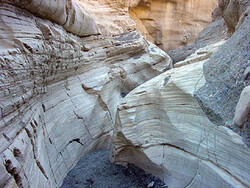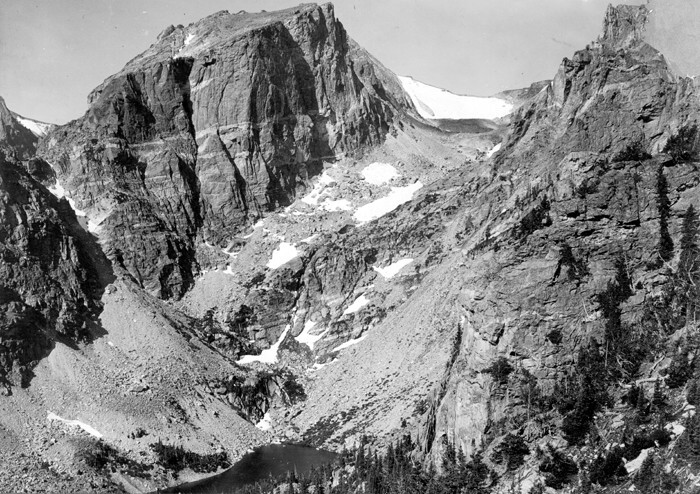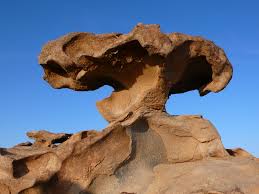Gearrannan Beach EarthCache
-
Difficulty:
-

-
Terrain:
-

Size:  (other)
(other)
Please note Use of geocaching.com services is subject to the terms and conditions
in our disclaimer.
EROSION :
Erosion means, in the geoscientific sense, the damage to, or creation of, surfaceforms through abrasion of more or less weathered rocks.
Forms of Erosion:
1.) fluvial erosion: through flowing waters forming, for example, V shaped valleys
 Mosaic Canyon, Death Valley
Mosaic Canyon, Death Valley
Mojave-Wüste, Kalifornien, USA
2.) glacial erosion : through glaciers moving down the valleys slowly and forming U shaped valleys
 Tyndall-Gletscher, Rocky Mountains, Montana, USA
Tyndall-Gletscher, Rocky Mountains, Montana, USA
3.) wind erosion: through moving air, and if dust and sand is moved there are greater effects

4.) marine erosion:
The kinetic energy of waves, when they reach mainland, causes weathering (eg on stones) for some metres around the inter-tidal zone - in areas of greater tidal differences the region of influence is bigger.

So there are typical coastal phenomenons like caves or natural bridges or sea stacks (Brandungspfeiler).
Coastal erosion occurs along beaches and shorelines. Both wind action and water action have important parts in this process and constantly change the boundary between land and water. Coastal erosion takes land away forever from one area to deposit it somewhere else.
The beach is constantly pounded by waves which eventually break fragments of ground and rock into sand. How hard a beach is hit by waves depends on lunar tides and prevailing winds.
There is no continuous groundcover on the beach, so sand dunes form easily. Wind blows sand particles from side to side. People sometimes build fences to keep sand from shifting so much. Eventually, the sand is blown away and water takes its' place. The land is gone.

Factors that influence erosion rates
The ability of waves to cause erosion of the cliff face depends on many factors.
The hardness or ‘erodibility’ of sea-facing rocks is controlled by the rock strength and the presence of fissures, fractures and beds of non-cohesive materials such as silt and fine sand.
The rate at which cliff fall debris is removed from the foreshore depends on the power of the waves crossing the beach. This energy must reach a critical level to remove material from the debris lobe. Debris lobes can be very persistent and can take many years to completely disappear.
Beaches dissipate wave energy on the foreshore and provide a measure of protection to the adjoining land.
The stability of the foreshore, or its resistance to lowering. Once stable, the foreshore should widen and become more effective at dissipating the wave energy, so that fewer and less powerful waves reach beyond it. The provision of new material coming onto the foreshore beneath the cliff helps ensure a stable beach.
The adjacent bathymetry, or configuration of the seafloor, controls the wave energy arriving at the coast, and can have an important influence on the rate of cliff erosion. Shoals and bars offer protection from wave erosion by causing storm waves to break and dissipate their energy before reaching the shore. Given the dynamic nature of the seafloor, changes in the location of shoals and bars may cause the locus of beach or cliff erosion to change position along the shore.
Coastal erosion has been greatly affected by the rising sea levels globally. There has been examples of increased coastal erosion on the Eastern Seaboard of the United States. Locations such as Florida have noticed increased coastal erosion. As a reaction to the increased erosion, Florida and its individual counties, have increased the budgets to replenish the eroded sands that attract visitors to Florida and help support its multi-billion dollar tourism industries.
About this special place
At this point you can see a very interesting formed beach. It's not the normal version of a beach as you would expect it.
Nearby is the famous Gerrannan Black House Village - a place worth visiting, too !
Questions to answer:
From the parking place go down to sea level and have a look at the beach.
1. Describe the beach.
2. Describe the colour and the shape of the stones of the beach.
3. What size are the stones?
4. Explain in your own words how the stones could have been created.
5. If you look at this beach, what does it make you think of?
Please send your answers by the mailfunction on my geocaching profile. You don't have to wait for a confirmation.
If you place a photo to your log please dont´t show the beach itself ! Turn around and show the landscape !
Additional Hints
(No hints available.)